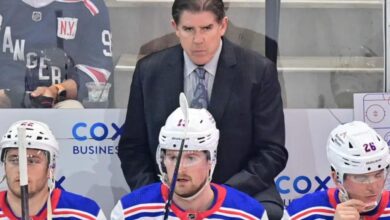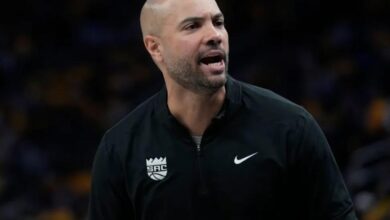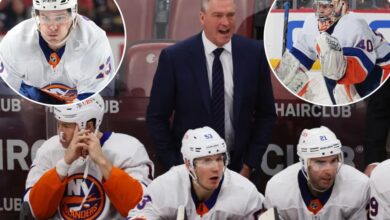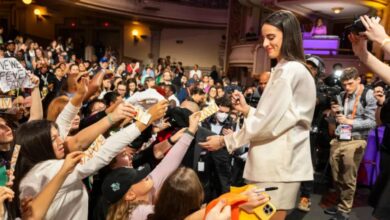Aaron Judge’s return to the MVP race underscores his unique Yankees role

Welcome back to the AL MVP race, Aaron Judge. We were expecting you.
In the 21 games since he returned from a right hip strain, Judge has had 12 homers and 20 walks, was hitting .342 and had a 1.356 OPS. That catapulted him to the AL lead in homers (18) and OPS (1.089) while rising to second in Fangraphs’ Wins Above Replacement and sixth in Baseball Reference’s calculation.
In Awards Watch this week, this surge enabled Judge to complete May in a crowded AL MVP front-runner group that again includes the player who nudged Judge out for this honor in 2021, the Angels’ Shohei Ohtani, pretty much every member of the Rays lineup, the Blue Jays’ Bo Bichette and Matt Chapman, the Rangers’ Marcus Semien and the Orioles’ Adley Rutchsman. (And yes, I see you lingering, Mike Trout.)
At this moment, I could not vote Judge for first place, notably for missing those 10 games — roughly one-sixth of the season — on the IL.
I am a huge attendance person. Games played matter. For someone such as Semien, durability is among his greatest annual assets. You know something the Rangers pretty much never worry about? The identity of the backup second baseman.
I have always thought WAR should include a calculation to subtract the WAR of your replacement when you do not play. I would call it the Byron Buxton rule. I have heard, over the years, for example, mounting cases for Buxton getting listed on the MVP ballot even as he was missing lots of games due to injury. The argument was essentially that he was so valuable in the games he played that it outweighed what he missed.
But your team does have to play those games, you know. And the star’s absence can often be devastating.
In the 10 games Judge missed, the Yankees were 4-6, and their collective output in that span from a roundtable of right fielders (Jake Bauers, Oswaldo Cabrera, Willie Calhoun, Franchy Cordero and Isiah Kiner-Falefa) was a .118 batting average and a .466 OPS. As a team, the Yankees had among the worst offenses in that period, averaging 3.5 runs per game while hitting .228 with a .669 OPS.
In a way, though, this also defines Judge’s case for value. We are in Year 2 of the Yankees going as Judge goes. The other members of the lineup are, at best, satellites to him. If he hits, the Yankees have a very good chance to win. When he doesn’t hit, the Yankees have a very good chance to lose. He is as close to a one-man band as there is in the sport.
In the 21 games since Judge returned, the Yankees are 14-7. In those seven losses, Judge had three combined hits, no RBIs and one extra-base hit (a double).
In the ninth inning of a 0-0 deadlock Wednesday night, Mariners manager Scott Servais opted to intentionally walk Judge as the go-ahead run with two outs. Calhoun made the final out. The Mariners ultimately won in 10 innings.
Now, this was an easier decision with Anthony Rizzo being held back one more day due to a neck injury and not hitting third and Giancarlo Stanton finishing his rehab assignment. But I still think the intentional walk is underused with Judge. Opposing managers should have a rule of ABJ — Anyone But Judge can beat them. Until others on the roster prove that is a bad strategy.
Here is another way to frame how dependent the Yankees are on Judge: In his 47 starts, the Yankees are 29-18. Judge has one homer in Yankees losses, 17 in their wins. He has a 1.457 OPS in the 29 wins and a .494 OPS in the 18 losses. That .963 difference is the second-largest for any player who has been in 40 games.
It is almost unfair to note that Oakland’s Brent Rooker has the biggest split, with a 1.716 OPS in wins and a .666 OPS in losses for a 1.050 differential. The A’s, after all, have just 12 wins. His teammate, Tony Kemp, was third at 1.072/.285 for a .788 differential.
The only other AL MVP contender in the top 10 in this category is Tampa Bay’s Yandy Diaz, whose 1.172 OPS in wins and .536 in losses gives him a .636 differential, which was the fifth largest (thanks to Lee Sinins of MLB Research for computing these numbers).
That Judge is again the Yankees MVP is overt. He is carrying the team, just like he did last year.
Whose career do you got?
MLB released the All-Star ballot on Wednesday, and National League first base is going to be quite a decision.
Pete Alonso and Atlanta’s Matt Olson rank 1-2 in the NL in homers, the Dodgers’ Freddie Freeman leads in OPS and St. Louis’ Paul Goldschmidt has a higher OPS than Alonso or Olson, is 7-for-7 in steals and is generally having a Goldschmidt-type season amid the Cardinals’ crisis.
In six of the past eight All-Star Games, the NL starter has been either Freeman or Goldschmidt — each has three starts.
And just to know the company of four-time NL All-Star first base starters should Freeman or Goldschmidt get there this season: Steve Garvey made nine starts, Johnny Mize had eight, Orlando Cepeda had five and Jack Clark, Willie McCovey, Stan Musial and Albert Pujols had four apiece.
Freeman and Goldschmidt have been the preeminent first basemen in the league for the past decade, essentially taking the baton from Pujols. They have won two of the past three NL MVP awards, and they are this week’s version of “Whose career do you got?” — with the understanding that the way they continue to play in 2023 screams loudly that their careers are far from complete.
Freeman has an MVP plus four other top-six finishes and an eighth- and a ninth-place finish. He is a six-time All-Star, won a Gold Glove and is a three-time Silver Slugger.
Goldschmidt has an MVP, two seconds, a third and two sixths. He is a seven-time All-Star, four-time Gold Glove winner and five-time Silver Slugger. Either Freeman or Goldschmidt has won the NL Silver Slugger at first base the past six seasons.
Freeman came up in 2010 and Goldschmidt the following season, and Freeman has 432 more career plate appearances.
They are not lumbering first basemen, but good all-around players. Goldschmidt, for example, has 154 career steals — among the most ever for a first baseman. In this all-around way, including the ability to steal a base, Goldschmidt reminds me of Hall of Famer Jeff Bagwell. It should be noted, though, that Freeman has 74 career steals, including being 8-of-9 this year.
Also — small picture — Freeman will carry a 20-game hitting streak into a weekend series against the Yankees.
For their careers, Freeman has a slash line of .300/.387/.512 with 302 homers, a 141 OPS-plus and 51.9 WAR (Baseball Reference). Goldschmidt has a slash line of .295/.391/.526 with 325 homers, a 145 OPS-plus and 60.4 WAR.
Both have had strong postseason performances. Freeman just has had more opportunities. In 201 career playoff plate appearances, Freeman has a slash line of .296/.403/.544 with 10 homers. In 102 playoff plate appearances, Goldschmidt has a .261/.333/.576 slash line with eight homers.
Neither wilts in the clutch. If I were trying to find a separator between two superb and similar players, it is that while Goldschmidt is a tough out, Freeman feels like he has been the champ for several years now as the guy I would want up in the biggest situations because he hits lefties and righties, he can hit elite stuff as well as anyone and pressure does not overwhelm him. Consider that Freeman’s career slash line with runners in scoring position — in 1,908 plate appearances — is .332/.452/.544.
One of my tough-at-bat gold standards is how a player does with two strikes, particularly in this high-strikeout age fueled by more velocity and pitch movement than ever. At the end of May, there were 217 players who had reached two strikes in at least 75 plate appearances. The MLB average in that situation was .171.
Goldschmidt was good in this area, 10th in the majors at .241. The second-best was Miami’s Luis Arraez at .281. The best?
That was Freeman…at .300.
Got my attention
It was a good winter for many free-agent categories. But as teams built their payrolls and rosters, the one class of player who spent most of the offseason (and even, in some cases, spring training) not finding a satisfying match was the veteran lefty reliever.
Two free agents signed early in the process in December. The Giants united Taylor Rogers with his brother Tyler by agreeing to a three-year, $33 million pact. And Matt Strahm signed a two-year, $15 million deal with the Phillies.
But then six veterans with pedigree — Andrew Chafin, Aroldis Chapman, Brad Hand, Matt Moore, Will Smith and Justin Wilson — waited. And waited.
Teams had prioritized spending elsewhere and figured this group was either fungible, too old or — in Chapman’s case — perhaps persona non grata. The players figured why jump at an offer in, say, early January, when a similar deal would be available closer to spring training or even during spring training. Better to wait and see whether the environment changed.
They all ultimately signed one-year deals ranging from $7.5 million (Moore with the Angels) to $1 million (Wilson with the Brewers). The earliest was Chapman on Jan. 27. Chafin, Moore and Wilson went down on Feb. 15, 16 and 18, respectively. Hand and Smith each signed on March 4.
Some wondered whether the Mets, in particular, would jump into this market to provide Buck Showalter with both a second lefty to team with Brooks Raley and general bullpen depth. They didn’t. Maybe they should have. Because the group, to date, has pitched pretty well.
We have to toss out Wilson, whom Milwaukee signed knowing he would not pitch before July as he continued recovering from Tommy John surgery.
But Chafin, Chapman, Hand and Smith were all top 30 in the Fangraphs version of reliever Wins Above Replacement through May, and Moore was 11th among relievers in Baseball Reference’s version. Again, it highlights the absurdity of a metric that does not have a singular computation.
WAR is not a great guide for relievers, especially with just one-third of a season of data. This was more to demonstrate that these relievers, considering the cost, have been good buys to date for their teams.
Chafin, with eight saves, a by-far-career-best 36 percent whiff rate and a 3.10 ERA, has helped turn the Diamondbacks bullpen away from the liability it was last year. Arizona has climbed into a tie with the Dodgers for the NL West lead and the best record in the league.
The Royals signed Chapman with the hopes of reviving him and trading him — Kansas City already is open for business. He might just have too much baggage for most teams to even consider adding Chapman for a pennant race, and that includes that on the mound he is still walking 15.9 percent of opposing hitters. But he also is averaging 99.6 mph with his fastball (it was down to 97.9 with the Yankees last year) and was whiffing 37.5 percent of hitters faced.
Hand has been traded at the deadline twice in his career, and it would not be surprising if the Rockies move him again. Hand is the same fastball/slider guy as always, but opponents just are not hitting him hard. He has yet to allow a homer in his first 22 appearances while striking out 32.2 percent of batters.
Moore went on the injured list with an oblique injury on May 28. But before that he had done a lot to suggest his bullpen breakout with the Rangers last year (1.95 ERA) was not a fluke: He had a 1.44 mark in 22 games for the Angels.
Smith was the closer for the 2021 champion Braves, then was not put on the playoff roster for the Division Series or ALCS last year for the Astros and did not appear in a World Series game even while on the roster. This year, for the first-place Rangers, Smith had nine saves and a 3.32 ERA through May.
Roster stuff maybe only I notice
There is no singular reason the A’s are appearing regularly now in sentences about historic ineptitude that include the 1962 Mets. But their inability to develop talent certainly is part of the brew.
They are in a division that has been dominated by the Astros, so why don’t we do a little compare and contrast (all of the data is through May)?
The Astros had used just 32 players, which tied for the fewest in the majors. Yet, 19 of those 32 were signed to their first contracts by the Astros. Only the Royals (21) had used more of their own original signs this year.
The A’s, on the other hand, had just 20 originally signed players who appeared this season on any major league roster. That was the fewest. The Astros had 51, trailing only the Dodgers (52) for the most.
The quantity provides — among other items — depth to both solidify the roster during a season and potentially use in trades.
The difference really shows in pitching, where the Astros keep remaking themselves with homegrown arms and the A’s slide toward ignominy.
Houston had 2022 AL Cy Young winner Justin Verlander sign with the Mets, have yet to receive an inning from injured homegrown Lance McCullers Jr., had homegrown Luis Garcia undergo Tommy John surgery after six starts and have homegrown Jose Urquidy out due a right shoulder injury. But the homegrown trio of Brandon Bielak, Hunter Brown and J.P. France has provided support behind the homegrown excellence of Cristian Javier and Framber Valdez.
In all, the Astros have had 23 of their originally signed pitchers work in the majors this year, including 12 that have made at least five starts. Think of it: Houston had 23 original-sign pitchers perform in the majors already; Oakland had just 20 total original signs in the majors representing all positions.
The A’s concluded May with a 6.63 ERA. That ranks as the second-worst in the modern MLB game (since 1900) to the 1930 Phillies’ 6.71. Philadelphia finished that season 52-102. The A’s had a 6.97 rotation ERA, which would be the worst ever. The current full-season high of 6.64 belongs to the 1996 Tigers, who finished the season 53-109.
The A’s have had just 10 originally signed pitchers work in the majors this year, including four who have made starts: Dylan Covey, Shintaro Fujinami, Sonny Gray and Mason Miller. Fujinami and Miller have pitched for Oakland. Fujinami, signed for one year at $3.25 million, has been among the majors’ worst pitchers. Miller, a third-round 2021 draft pick, looked promising through four starts before incurring a forearm injury that sidelined him.
Last licks
So if you are going to be as bad at talent accumulation on the front side, then you really have to nail your trades and signings. And the A’s have not done that.
Look, if you were a conspiracy theorist who believes the “Major League” premise that A’s ownership wants to tank in Oakland to make getting out of town to Las Vegas easier, this would be a place to look. Because the same front office of Billy Beane, David Forst, Billy Owens, etc., that had done so well in the trade market for years to keep the small-payroll A’s relevant, suddenly went, what, dumb?
Since the best of times with Tim Hudson, Mark Mulder and Barry Zito, which is now two decades ago, the A’s have not really succeeded in the amateur market for starting pitching. But they did excel in the trade market and the low-end free-agent market.
The A’s made the playoffs each year as recently as 2018-20, when their best starters came via trades — Chris Bassitt, Mike Fiers, Sean Manaea and Frankie Montas — or a small free-agent signing in Brian Anderson.
Their trades in recent years have, to date, netted little — or worse. They dealt Bassitt, Manaea and Montas and also their best three homegrown position players in years — Matt Chapman, Sean Murphy and Matt Olson. All of it, to date, has contributed to the problems rather than helping to form the next Oakland contender.
The A’s ended May with the three worst pitchers by WAR (Baseball Reference) in the majors: Fujinami (minus-1.9) was a free-agent signing, Ken Waldichuk (minus-1.2) was the key player in the Montas trade with the Yankees and Kyle Muller (minus-1.1) was in the Murphy trade with the Braves.
Adam Oller (minus-1.1) was fifth-worst. He came in a trade with the Mets for Bassitt. James Kaprielian (minus-1.0) was seventh-worst. He came in a trade with the Yankees for Gray. Drew Rucinski (minus-0.8) was 16th-worst. He was signed for one year at $3 million after a four-season stint in Korea. Domingo Acevedo (minus-0.7) was 22nd-worst. He had been designated for assignment by the Yankees after the 2020 season.
The A’s DFA’d him in early May, as they did to Jeurys Familia, whom they had signed during spring training. Familia had a minus-0.5 WAR, 42nd-worst. Trevor May (minus-0.4) was 55th-worst. He signed a one-year, $7 million free-agent deal. Luis Medina (minus-0.4) was 64th-worst. He was also part of the Montas deal.
A team simply cannot squander its few homegrown assets and the pennies its owner allows to be spent at this level without staring at being historically bad.
Get Best News and Web Services here







